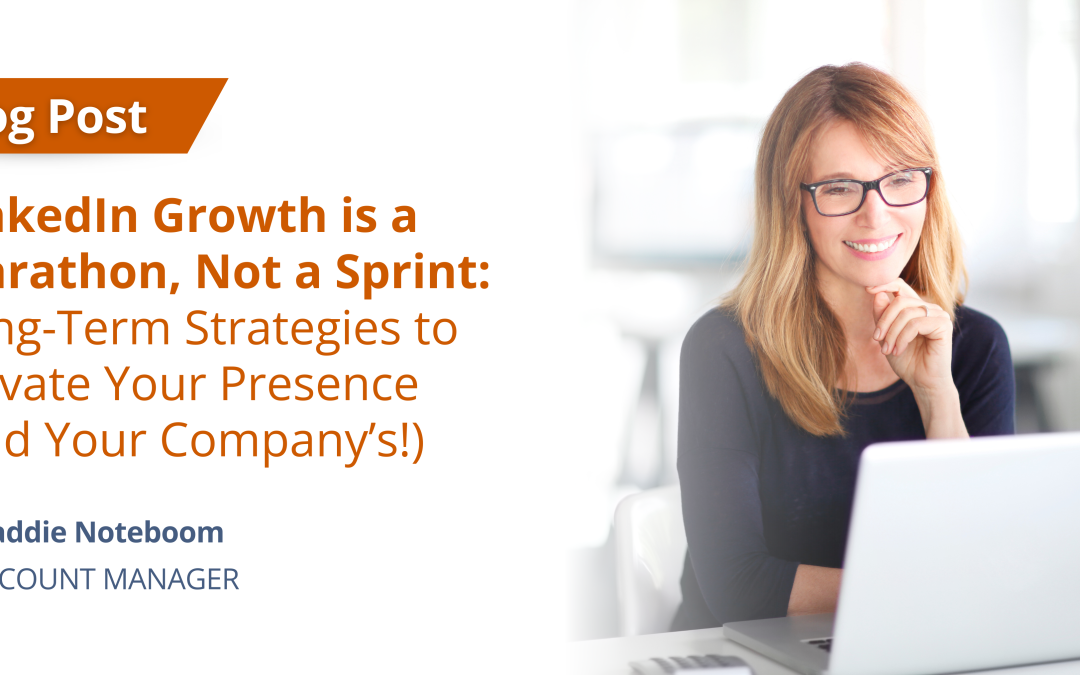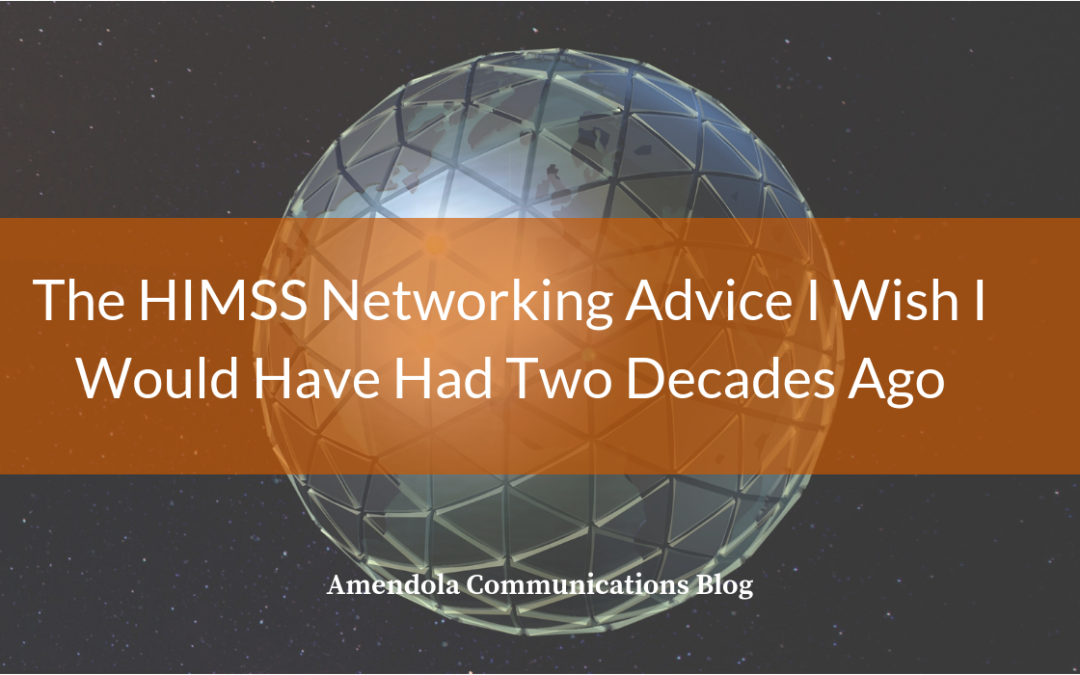
by Maddie Noteboom | Oct 2, 2024 | Blog
LinkedIn has evolved beyond a simple job-hunting platform—it’s now a powerful tool for building professional influence and enhancing corporate brands.
But we oftentimes can forget that building a strong presence on the platform is a marathon, not a sprint. Sure, it’s easy to want immediate results, but much like professional relationships, growing your LinkedIn influence takes time, patience, and persistence.
In my time working at Amendola, I’ve seen how an active LinkedIn presence can open doors, foster relationships, and position individuals AND their companies as industry thought leaders. When employees are engaged and visible on LinkedIn, they’re not just investing in personal growth—they’re actively driving results for the company.
As the human face behind the brand, employees can foster more meaningful interactions than brand channels alone. Research supports this, showing that content shared by employees has far more reach, receives more engagement, and generates more leads than content posted by the company itself:
- 81% of B2B buyers consider LinkedIn a significant source of research before making a purchase decision (Fronetics).
- Employees on average have 10 times more connections than their company’s LinkedIn followers (LinkedIn), giving their posts greater potential for expanding visibility.
- 91% of B2B sales are influenced by word of mouth (Demandbase), underscoring the power of employee advocacy in generating authentic and impactful engagement.
Looking to help your employees not only build their personal brand, but also contribute directly to the company’s overall success? Here are a few strategies we recommend to our clients that have proven long-term impact.
Optimize Your Profile
Your LinkedIn profile is your personal brand’s landing page. Ensure it’s fully filled out with a professional headshot, a concise yet compelling headline, and a detailed experience section. A polished profile elevates both your credibility and your company’s reputation. Here are some other elements to consider:
- Add a header image that aligns with your professional brand
- Include keywords in your headline and/or summary
- Avoid using overused buzzwords/phrases
- Personalize your URL, shorten it and add to your email signature
- Be somewhat selective when choosing skills and endorsements
- Provide details about education, qualifications, volunteer experience and accomplishments, but avoid bragging.
Share Valuable Content
What you post on LinkedIn should provide value to your network. Share insightful articles, industry news, and your perspective on current trends. When you do this, you position yourself—and by extension, your company—as a thought leader.
Consistently sharing valuable content helps attract potential clients and partners. I recommend following the 80/20 rule: 80% of your posts should deliver value—sharing industry news, thought leadership, and relevant insights—while only 20% should promote you or your company’s offerings.
Remember: LinkedIn is a space where professionals come to learn, engage, and connect—not just to be sold to. My colleague Brandon Glenn explains the 80/20 rule in more detail here.
When posting an update to LinkedIn, keep these optimization strategies in mind:
- Post frequently (at least one time per week – five is optimal), focusing on quality over quantity
- Two posts that offer followers valuable insights are better than five posts that promote products
- Offer informative, insightful, inspirational content; users are looking for information and education
- Optimize posts by including an attractive image, graphic, or video; ensure text is legible
- Include a stat, quote, or interesting line at the beginning of the post from the article rather than the title to make your post stand out
- Ask questions to encourage conversation.
Engage, Comment, and Share
It’s not enough to post and log off. Engagement is key. Comment on industry discussions, share others’ posts, and add your perspective. By actively participating in conversations, you’re not only building relationships but also increasing your company’s visibility.
Stay Active and Be Consistent
LinkedIn’s algorithm rewards consistency. Make it a habit to engage with the platform regularly, whether by posting, liking, or commenting. A consistent presence keeps you top of mind within your network, and the more visibility you gain, the more likely it is that people will associate your company with thought leadership.
Invite and Follow New Accounts
Expanding your network is crucial. Don’t limit yourself to people you already know—reach out to professionals in your industry, potential clients, and partners. Joining relevant groups and becoming an active participant in discussions can also help you gain recognition and authority. A growing network is mutually beneficial, exposing you and your company to new opportunities and increasing your company’s influence in the industry.
Be Patient
Building a strong presence takes time. You won’t see overnight success, so stay patient. As your network grows and your engagement increases, so will your influence—and by extension, your company’s credibility.
When employees are active on LinkedIn, it creates a ripple effect. Every post, comment, or share contributes to your company’s overall brand presence. In B2B, trust and relationships are everything. The more employees position themselves as experts, the more the company is seen as a leader in its field.
Remember: LinkedIn growth is a marathon, not a sprint. Building influence and trust takes time. Every thoughtful interaction you make adds up over the long run – and sets you up for long-term rewards for you and your company.

by Brandon Glenn | Aug 7, 2024 | Blog
We all understand that the role of a corporate marketing department, among other things, is to promote its company, educate potential customers, and strengthen the company’s brand image – with the ultimate goal of driving higher sales.
Most marketers know how to articulate the benefits and value proposition of their company’s products, and, generally, they do a solid job of it.
What fewer marketers understand is when NOT to talk about their companies – particularly on social media. (For the purposes of this article, we’ll focus on LinkedIn because it’s the most valuable social site for business users.)
It’s important for marketers to remember that social media platforms are intended to encourage two-way communication, as opposed to functioning like a megaphone used to blast messages.
Accordingly, corporate social media must focus on providing value to followers. Indeed, corporate social media success requires putting followers’ wants and needs above the company’s own objectives.
The 80/20 rule for social media success
The 80/20 rule is the answer for keeping marketers focused on delivering value to their audiences. This cardinal rule for social media simply holds that 80% of the content posted to a social account should deliver value to the audience (think general industry news, opinions, and observations) while it’s ok for the other 20% to be blatantly promotional.
In my experience, most corporate marketing departments have mastered the 20% aspect of the rule but tend to struggle with the 80% part. Admittedly, it can be a little daunting in the beginning to understand and figure out how to fulfill this goal.
First, start with a list of keywords that pertain to your company’s niche in the industry. For example, if the company works in the virtual care space, create news alerts and perform searches for keywords like “telehealth,” “virtual care,” “virtual nursing,” “value-based care,” “healthcare staffing shortages,” and “healthcare burnout,” for example. Relevant hash tags can also help to surface third-party articles that discuss industry trends.
These articles make up the 80% of non-promotional content, while the other 20% can consist of product and technology-related information specific to the company.
Professionals go to LinkedIn when they need information, making it a great place to demonstrate thought leadership by sharing insights, stats, and case studies. These users want to discuss topics in their industry, cultivate professional connections, and better themselves as professionals along their career trajectory.
By adhering to the 80/20 rule, brands can help LinkedIn users accomplish these objectives. Just keep in mind the cardinal rule of social media: It’s not all about you.

by Jodi Amendola | Feb 7, 2019 | Blog
With HIMSS19 right around the corner, my team and I are excited about networking with current and prospective clients, reconnecting with old friends and colleagues, and facilitating meetings with the best healthcare and health IT media and analysts in the business.
Even though HIMSS is a few days long, sometimes it seems like there aren’t enough hours in each day to accomplish everything you need and want to get done. With about 20 HIMSS annual meetings under my belt, I’ve learned a few networking strategies along the way to get the most marketing ROI possible from the time we all invest.
Whether you’re taking part in HIMSS19 as a vendor/exhibitor or individual attendee, here are some tips to make the most of your HIMSS networking opportunities:
Face time
Even if you’re tired after a long day of meetings, be sure to take advantage of the many face-to-face networking events at HIMSS. Meeting with other health IT execs in a more informal setting is a great way to make personal connections which in turn can become strong business relationships.
Pro tip: Find common ground and talk about something interesting or fun related to the show.
Pitch perfect
Whether you’re meeting contacts on the exhibit hall floor, in your company’s booth, or at a networking event, remember that there’s a fine line between promoting yourself and being overly self-promotional.
One way to talk about your organization is to come prepared with a well-honed elevator pitch. This is a two- to three-sentence description of your company that’s simple, easy to understand, and memorable. Don’t get bogged down in jargon and technical specs. Explain your product or service in laymen’s terms.
At our agency, every elevator pitch must pass the “Connie’s mother’s test.” In other words, if you explained your story to your friend’s mother or neighbor would they understand it? If not, you probably need to modify it.
If you’re an executive who’s meeting with media and analysts, that’s good advice for those situations, too. Talk to them just as you would anyone else you meet at the show. Be friendly, be yourself, and don’t be overly self-promotional. You want to position yourself as an industry thought leader, which means that sometimes the conversation will turn toward wider industry trends rather than specific solutions.
Pro tip: If you serve multiple client bases that use your products and services in different ways, come armed with an elevator pitch for each. They need not be completely different, but should speak to the pain points of the person you’re talking to.
The social network
Although you shouldn’t ignore social media platforms such as LinkedIn, Facebook and Instagram, you’ll likely get the most exposure by engaging with other attendees on Twitter. If you want to establish yourself as a thought leader, I suggest living tweeting from the show. A simple comment on what you learned about a session, or something interesting you saw or heard on the show floor makes for good fodder.
If you want to tweet but you’re on a tight schedule, one tactic is to retweet influencers such as the HIMSS Social Media Ambassadors and trade media with a heavy presence at the show. Also consider engaging with anyone who is effectively using the conference hashtag #HIMSS19, as well as any of the other official HIMSS19 hashtags such as #Aim2Innovate, #ChampionsOfHealth, #Connect2Health, #EmpowerHIT, #Engage4Health, #HITworks, #PopHealthIT and #WomenInHIT. (When you look at the conference hashtag feeds, be sure the list is sorted by “top” rather than “most recent” to filter out some of the noise.)
You should always be authentic, and it’s great to choose tweets that resonate with your own brand. But it’s okay to retweet something interesting or funny even if it isn’t 100 percent “on message.” In fact, many attendees scroll right by posts from vendors that only tweet their sales pitch and booth number. Of course, you should post links to your own blog posts, company announcements, events and promotions. But it’s always better to join a conversation rather than trying to dominate it.
You may want to also consider taking a team approach to your conference tweets. Platforms such as TweetDeck make it easy to post from multiple accounts at once, including your personal account and those of your team members as well as your official company account. This is a great time to follow new influencers and to engage with them to get likes, retweets and (hopefully) new followers.
Pro tip: If you have a few extra moments, you can personalize a retweet by choosing “quote tweet” and adding a brief comment to make it stand out even more.
Go beyond the big show
Trade shows are a fantastic opportunity to connect with potential clients and business partners as well as analysts and the media, but if you fail to follow up, you’ve missed a key opportunity.
Too often, attendees collect business cards, only to toss them in a drawer once they get home. You can use an app that turns cell phone snaps of business cards into text files or make photocopies of them. Send those to your marketing team so they can add them into your prospect list, and don’t forget to connect on LinkedIn.
Pro tip: Write some details about the person you met on the back of their business cards as soon as you can, so you have context when you follow up.
Remember to have fun
Any large conference can be busy and overwhelming. Planning ahead will help, whether it’s deciding which network events to attend, having the official conference social hashtags at your fingertips, or making plans to meet long-distance contacts for a quick cup of coffee.
I’m looking forward to the show and hope to see many familiar and new faces in Orlando! Here’s to a great HIMSS!



